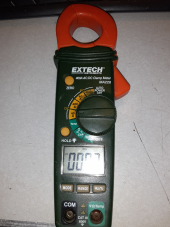AgroVenturesPeru
New Member
- Joined
- Sep 19, 2020
- Messages
- 411
I bought a Prasek PR-54 recently, and watched a video tutorial. The volts seem spot on, which you measure with the diodes. I tested a 9V battery, the wall outlet, and my solar MC4 strings. The first two measurements were spot on. The last one, measuring VOC on a partly cloudy day, seemed also within reason.
Amps are another story. You have to use the jaws to measure amps. It can supposedly measure ranges of 40A or 400A, but can only measure one wire at a time, so, if you set the unit to AC amps, and measure a cable that holds both Line and Neutral wire, the thing won't even give a reading.
I set it to DC 40A and attached it around the 8 wires heading into my solar string box:
4 Groups, each with a negative and positive.
My array: 4s4p
The first three groups all measured somewhere in the ballpark of 2-3 amps on both their positive and negative cable. Those panels have a Vmp of 41.7V and an Imp of 9.6A.
The fourth group has another brand of panel with mostly the same specs: 41.6Vmp and 9.86Imp.
The positive wire measured about 3 Amps, but the negative wire measured about 6 Amps.
This was pretty consistent, as I measured everything three times over the course of about ten minutes, and the outside light wasn't fluctuating very much during that time frame.
One thing I noticed, was that even when holding the multimeter far away from any wires, it still gave off a reading of around 1 amp. I can understand the thing being inaccurate, but to consistently show a reading of around 3amps on a positive wire, and consistently show a reading of twice that for the same group's negative wire...
Amps are another story. You have to use the jaws to measure amps. It can supposedly measure ranges of 40A or 400A, but can only measure one wire at a time, so, if you set the unit to AC amps, and measure a cable that holds both Line and Neutral wire, the thing won't even give a reading.
I set it to DC 40A and attached it around the 8 wires heading into my solar string box:
4 Groups, each with a negative and positive.
My array: 4s4p
The first three groups all measured somewhere in the ballpark of 2-3 amps on both their positive and negative cable. Those panels have a Vmp of 41.7V and an Imp of 9.6A.
The fourth group has another brand of panel with mostly the same specs: 41.6Vmp and 9.86Imp.
The positive wire measured about 3 Amps, but the negative wire measured about 6 Amps.
This was pretty consistent, as I measured everything three times over the course of about ten minutes, and the outside light wasn't fluctuating very much during that time frame.
One thing I noticed, was that even when holding the multimeter far away from any wires, it still gave off a reading of around 1 amp. I can understand the thing being inaccurate, but to consistently show a reading of around 3amps on a positive wire, and consistently show a reading of twice that for the same group's negative wire...



